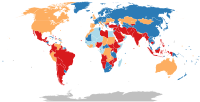
Photo from wikipedia
Crayfish have experienced extensive assemblage reorganization as a result of global change, with some species becoming globally invasive and others becoming rare or extinct. We combined historical and contemporary sampling… Click to show full abstract
Crayfish have experienced extensive assemblage reorganization as a result of global change, with some species becoming globally invasive and others becoming rare or extinct. We combined historical and contemporary sampling data to determine temporal trends of crayfish assemblages of Wyoming, USA, identifying winners and losers over a ½ century of change (1969–2020). We first documented range expansions of several species, including the Virile Crayfish Faxonius virilis (Hagen, 1870), Ringed Crayfish Faxonius neglectus (Faxon, 1885), and Rusty Crayfish Faxonius rusticus (Girard, 1852) as well as range contractions of the Calico Crayfish Faxonius immunis (Hagen, 1870) and Pilose Crayfish Pacifastacus gambelii (Girard, 1852). We then used multispecies occupancy models to investigate potential mechanisms behind the replacement of F. immunis by F. virilis as the most commonly detected crayfish species in Wyoming over time. We hypothesized that F. virilis is more likely to competitively displace F. immunis from more permanent waterbodies, whereas F. immunis is more likely to persist in more ephemeral habitats because of its superior burrowing ability and tolerance of low dissolved oxygen concentrations. Our occupancy models supported this prediction, with F. immunis occupancy declining at more permanent sites in the presence of F. virilis, but F. immunis occupancy was unaffected by F. virilis in less permanent sites. We also found positive associations of F. virilis occupancy and detection probability with water temperature, suggesting that warmer streams may be more vulnerable to new invasions or spread by this species in nonnative regions of western North America. Our results highlight the value of regular, statewide crayfish surveys through documenting substantial changes in Wyoming’s crayfish assemblage structure that may be driven by habitat-mediated competitive interactions.
Journal Title: Freshwater Science
Year Published: 2023
Link to full text (if available)
Share on Social Media: Sign Up to like & get
recommendations!